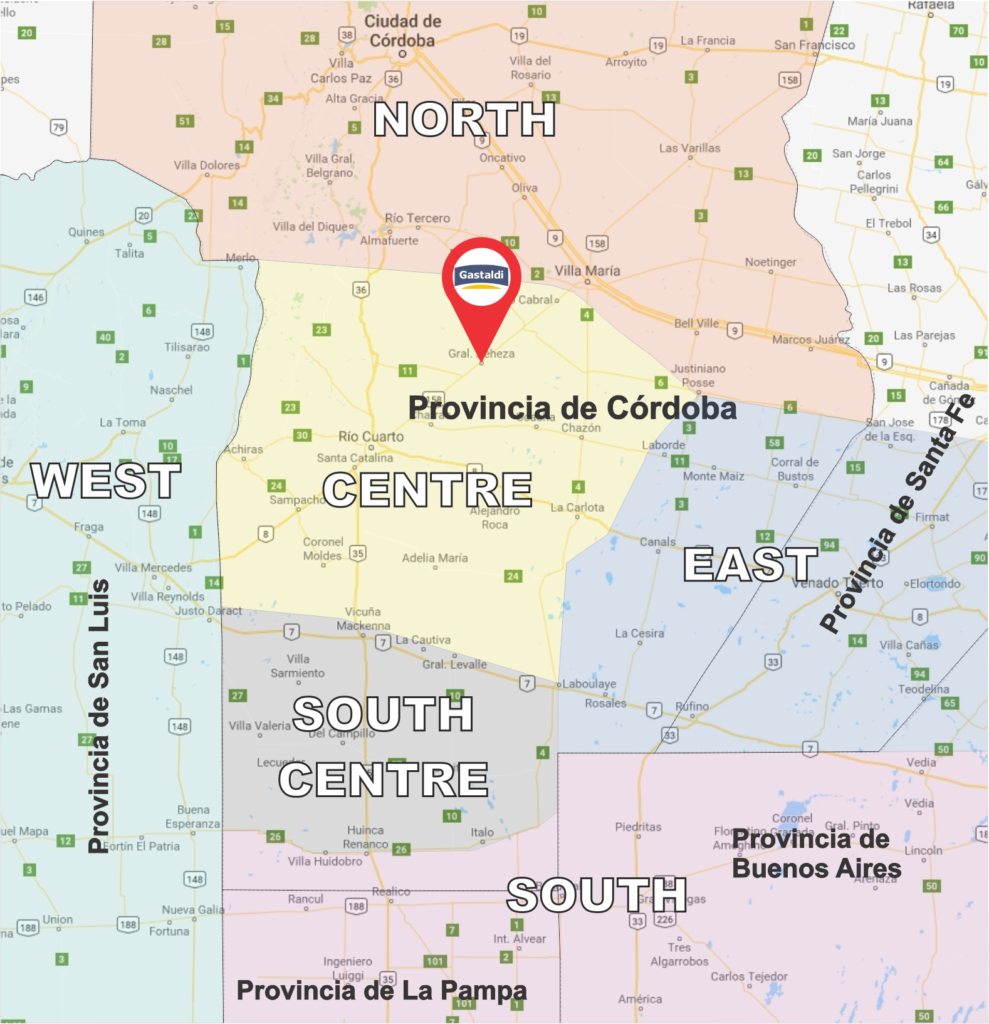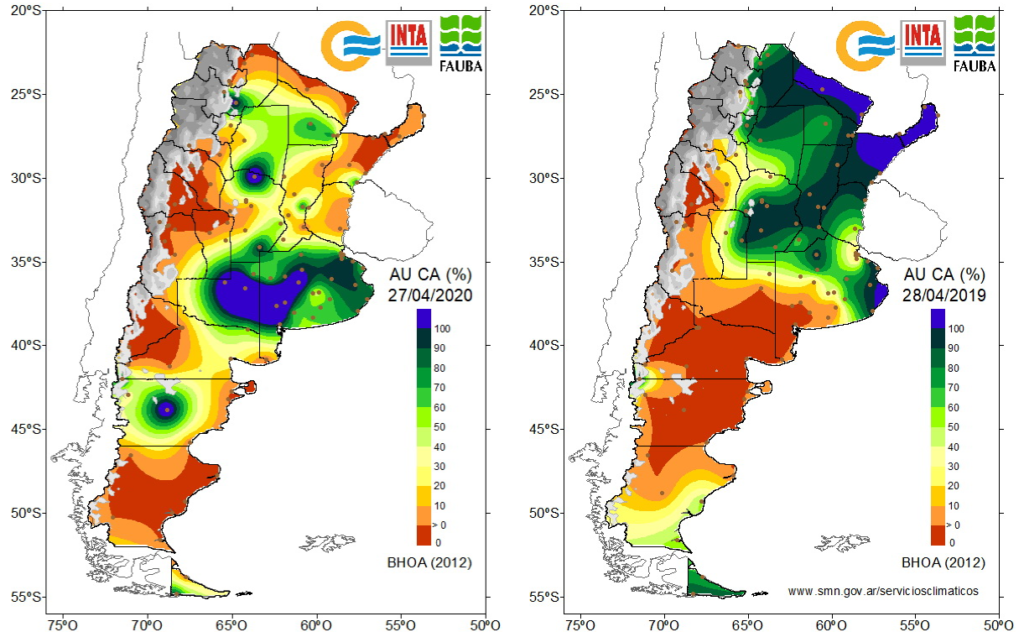Argentine Peanut Crop Report
Season 2019/2020 – #5
General Overview
Although the state of the peanut crop in Argentina presents heterogeneous characteristics according to the geographic area being analyzed, in general terms the crop is in good to very good condition. Despite the fact that April did not bring heavy rains to the peanut region, the crop managed to reach acceptable percentages of maturity, so the digging activities began to develop as planned. The exception occurs in those areas that came with a marked water deficit (mainly West and South) which will see their production yields reduced. There are also peanut lots affected by soil diseases (Sclerotinia for example), in which yield losses are also expected. Unlike season 18-19, where the good results were homogeneous and generalized, season 19-20 will be characterized by heterogeneous figures. The North, South-Centre and South zones present the best panorama, while the West and Center zones present a comparatively inferior panorama. In any case, we estimate an overall weighted average yield of between 3 and 3.2 tons / ha (in shell peanuts, dry and clean base).
As of the date of preparation of this report, the advance of the digging tasks is around 76% of the total planted area. The progress has been quickly and efficiently, due to the good sanitary condition of the plants and the adequate soil moisture conditions. We estimate that these tasks will end in mid-May, as long as adverse weather events do not develop. It should be noted that most of the crop is in the R8 phenological state (harvest maturity), so water consumption is practically nil. In addition, as we approach winter, days are shorter and with less sunlight, so the cycle of filling carried out by the plants is considered finished. Therefore, it is essential to continue advancing rapidly with the digging tasks, in order to reduce the probability of incurring greater losses at the field level.

Peanut digging tasks in Argentina

Digging progress as of 01-05
Regarding the harvesting activities, although it has already started in those lots that were dug early, the progress today does not exceed 5% of the total planted area. It is worth mentioning that the first kg of in shell peanuts received in the storage and processing plants arrived with humidity levels around 11-12%, so it was not necessary to resort to artificial drying processes.

Harvesting tasks in Argentina

Harvesting progress as of 01-05
Regarding the state of the crop, the comparison with the results presented in the previous report shows the following:
• Excellent: 10% (current) vs. 10% (last month)
• Very good: 30% vs 28%
• Good: 30% vs. 20%
• Regular: 23% vs 35%
• Bad: 7% vs. 7%

Crop condition as of 28-04-2020
Main Peanut Area Map
The main peanut area in Argentina includes the provinces of Cordoba, La Pampa, San Luis and Buenos Aires. In general terms, it can be divided as follows:

Main peanut area in Argentina
Rainfall and Temperature Analysis
Little rainfall was recorded around April 24th in the North, East and South areas, but it was not enough to cause significant changes in the crop. In general terms, there have been no heavy rains reported throughout April.
At the beginning of the month (around April 10th) there was a general drop in temperatures throughout the peanut area and some frosts occurred. The areas most affected by this phenomenon were the South (south of La Pampa) and the East (northeast of Buenos Aires), therefore, digging tasks in the affected fields were intensified. However, despite the initial concern, the frosts were not intense and did not produce significant effects.

Accumulated rainfall in the province of Cordoba from April 24th to 27th
Available Water Content in Cordoba
The maximum retention capacity or “field capacity” implies that the extraction of water by the vegetables occurs without any difficulty. Between the field capacity and the permanent wilting point there is the range of what we call useful water in the arable layer.
The figure shows that, at the end of April in the peanut area, the average values are around 50% of useful water in the soil profile (field condition). Comparing with the same date last year, we can see that this indicator was at 80%.

Available Water Content in Argentina as of April 27th, 2020 vs situation as of April 28th, 2019
Crop-related Tasks
Soil diseases such as wilt (Sclerotinia) and peanut smut are still present in the crop and must be monitored carefully. Those lots that have been affected by any of these diseases saw the digging process accelerated, in order to minimize losses. Problems were evidenced mainly in long-cycle cultivars, in which the maturity percentage had not reached 45%, but had to be dug anyways. Yield losses will then be greater compared to shorter cycle cultivars, which have a maturity close to 60%.
On the other hand, the high percentage of ambient humidity increases the likelihood of fungal diseases appearance. Due to the risk that these diseases develop, farmers in all areas carried out an average of 3.5 fungicide applications throughout the entire growing cycle.
Final Remarks
Argentine peanuts are going through the last critical stages of the season, which will define the results of the crop 2019-2020. The meteorological conditions that have occurred up to now have been ideal to carry out digging and, to a lesser extent, harvesting tasks. Sunny, cool and windy days have made it possible for the Argentine peanut sector to focus on field work with all the existing resources.
In general terms, we will have a good peanut crop in Argentina this year, given that acceptable yields and low incidence of quality problems are expected. Although results of the previous season will not be repeated, the expectations are very good when compared to the historical records of previous seasons.
It is essential that the good weather conditions continue in the coming weeks, so as not to incur greater losses in the fields and to be able to receive in shell peanuts in the production plants with acceptable humidity levels, avoiding the need to implement artificial drying at large scale during reception.
Do you have a commercial inquiry?
Request for price quote
Other questions or comments?
Contact us: stembras@gastaldihnos.com.ar
Follow Gastaldi on social media:



